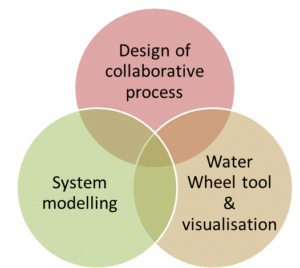Wheel of Water research programme
 The Wheel of Water is a 6-year government-funded research (2011 – 2017) of collaborative decision making for setting water quality and quantity limits in New Zealand. The project supports integrated decision making and processes that take into account environmental, economic, social and cultural implications at the catchment scale. The programme is led by Aqualinc Research Ltd and also involves researchers from Landcare Research, AgResearch, Tipa and Associates, Will Allen and Associates, Participatory Techniques Ltd, ESR and AERU. This page lists some of the outputs I was involved in as part of my involvement in this programme, a more comprehensive listing of outputs is available from The Wheel of Water Research Programme site.
The Wheel of Water is a 6-year government-funded research (2011 – 2017) of collaborative decision making for setting water quality and quantity limits in New Zealand. The project supports integrated decision making and processes that take into account environmental, economic, social and cultural implications at the catchment scale. The programme is led by Aqualinc Research Ltd and also involves researchers from Landcare Research, AgResearch, Tipa and Associates, Will Allen and Associates, Participatory Techniques Ltd, ESR and AERU. This page lists some of the outputs I was involved in as part of my involvement in this programme, a more comprehensive listing of outputs is available from The Wheel of Water Research Programme site.
The research was carried out in two phases.
In the first half of Phase 1, the Wheel of Water programme team developed an understanding of the key process design elements that might be included in the Wheel of Water process, and conducted research into the background, theory and practical challenges associated with elements.
![]() Effective indicators for freshwater management: attributes and frameworks for development This 2012 report by Will Allen, Andrew Fenemor and David Wood outlines key steps for indicator-based reporting. These include include involving the right people, and clarifying with them the purpose, scope and scale of the management system under consideration. Attention is also paid to indicator chanracteristics, and the capacities and systems required to support collaborative adaptive management.
Effective indicators for freshwater management: attributes and frameworks for development This 2012 report by Will Allen, Andrew Fenemor and David Wood outlines key steps for indicator-based reporting. These include include involving the right people, and clarifying with them the purpose, scope and scale of the management system under consideration. Attention is also paid to indicator chanracteristics, and the capacities and systems required to support collaborative adaptive management.
In the second half of Phase 1 we sought to test these learnings by piloting a collaborative decision making process, and to test the utility of the WaterWheel diagram as part of this process. Two case study settings were used: one in the Wairau Valley (Marlborough), and the other in the Mangatarere catchment (Wairarapa).
![]() Fraser, C., Fenemor, A., Turner, J., Allen, W. (2014) The Wheel of Water Research Programme: Designing collaborative catchment decision-making processes using a WaterWheel– reflections from two case studies, MBIE, C1205601. Aqualinc Research Limited. A short summary of this work is also available here.
Fraser, C., Fenemor, A., Turner, J., Allen, W. (2014) The Wheel of Water Research Programme: Designing collaborative catchment decision-making processes using a WaterWheel– reflections from two case studies, MBIE, C1205601. Aqualinc Research Limited. A short summary of this work is also available here.
In Phase 2 of the Wheel of Water Research programme we worked with collaborative limit setting initiatives in Takaka (Tasman District) and Ruamahanga (Greater Wellington Region). A number of outputs were developed.
![]() Kilvington M, Allen W, Sinner J (2016) Understanding how change is motivated – Workshop for water management decision makers. This workshop provides an introduction to some of the existing science around supporting and motivating change in environmental management settings.
Kilvington M, Allen W, Sinner J (2016) Understanding how change is motivated – Workshop for water management decision makers. This workshop provides an introduction to some of the existing science around supporting and motivating change in environmental management settings.
A number of other resources are available from the The Wheel of Water Research Programme – resource page. These include the following reports:
- Cultural Indicators, Monitoring Frameworks and Assessment Tools

- Exploring Limits using integrated modelling and the wheel of water graphic
